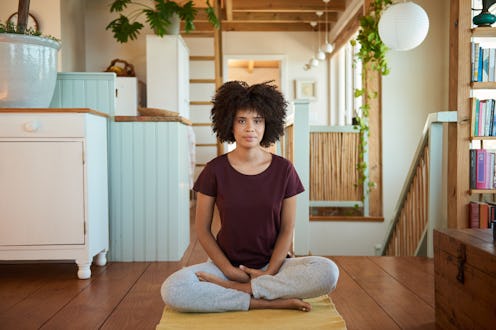Fitness
How To Do Fire Log Pose For More Mobile Hips
It’s like criss-cross applesauce, but better.

You might not realize it, but some simple yoga poses can often do the most work. Case in point? The fire log pose. While it looks like the perfect cross-legged position for relaxing on the couch, it’s actually one of the most intense hip-openers in yoga.
Fire log pose — also called double pigeon or agnistambhasana — is a seated posture that works wonders for loosening tight tips. To do it, you sit with your back straight, arms at your sides, and your legs crossed in front of you with one on top of the other and both shins lined up, says Brandt Passalacqua, the founder, director, and lead teacher at Breathing Deeply Yoga Therapy. The position makes your legs look like two logs stacked on a fire, hence the name.
The pose might look chill, but you’ll feel things working the moment you settle into it. According to Passalacqua, the move provides a deep stretch for your outer hips, groin, glutes, and thighs, which is great if you have some tension going on. “One of the biggest benefits of fire log pose is that it counteracts long periods of time spent sitting,” he adds. Even though it’s a seated pose itself, dropping into fire log and stretching your hip flexors in this unique way will help relieve tightness.
If you do fire log pose on a regular basis, you’ll start to notice that you have more flexibility and mobility in your hips. “It can also help improve your posture,” Passalacqua says, because it gets you into the habit of sitting up straight and properly aligning your spine. Keep scrolling below for fire log tips, including how to modify the pose.
How To Do Fire Log Pose
Here, Pasalacqua shares the best way to practice fire log pose so you can properly stretch your hips.
- Start by sitting on your yoga mat with your legs straight in front of you.
- Bend your right leg at the knee.
- Bring your calf toward your body and rest it on the mat in front of you.
- Bend your left leg and bring your left calf toward the right one.
- Stack your left ankle on top of your right knee and your left knee on top of your right ankle, with your left calf resting on top of your right one.
- Sit with your back and neck up straight.
- You can place your hands on the floor outside your hips or rest them on your legs.
- Hold this pose for 30 seconds to two minutes and then switch sides.
How To Modify Fire Log Pose
Fire pose will feel intense if you have tight hips and glutes. To ease up, go ahead and grab a couple of props, like pillows or towels. Passalacqua recommends sitting on a cushion to create more space for your legs. “This can also help support your hips and lower back,” he says.
If you’re having trouble stacking your legs like logs, bring your top leg out a bit further from the bottom leg and place a yoga block under your ankle. “This will put less pressure on your knee,” Passalacqua says.
To take your fire log pose to the next level, try sliding the ankle of your top leg beyond the knee of your bottom leg rather than stacking it right on top. According to Passalacqua, this will provide an extra deep stretch for your hips.
“Another option to deepen the stretch while further engaging your back is to do a forward fold,” he notes. “While in fire log pose, fold forward from your hips. Bring your arms in front of you and stretch them onto the floor.”
To go even deeper, engage your lower back by doing a couple of twists. “Once in fire log pose, put one hand on the knee of the leg that’s on top, then put the other hand on the floor behind you on the other side of your body,” he explains. “Twist to the side, then repeat when you switch your legs and twist on the other side.”
Common Mistakes To Avoid
Since this pose brings a lot of attention to your hips, check in with yourself to make sure you aren’t overexerting your knees, especially if you have an injury. “If you’re in pain or if something feels wrong, stop trying to practice the pose,” Passalacqua says. “If you struggle to stack your knees and ankles, don’t push them. Instead, try using yoga blocks or cushions in a modified pose to start building up the flexibility you’ll need.”
Since one of the main benefits of this pose is improved posture, double-check that your back stays straight the whole time, too. “You may be so focused on positioning your legs that you forget about your back,” Passalacqua notes. “Sitting up straight allows you to hold the pose correctly and get the most out of it for your lower back.”
Studies referenced:
Xu, D. (2022). Effects of Yoga Intervention on Functional Movement Patterns and Mindfulness in Collegiate Athletes: A Quasi-Experimental Study. Int J Environ Res Public Health. doi: 10.3390/ijerph192214930.
Source:
Brandt Passalacqua, founder, director, lead teacher at Breathing Deeply Yoga Therapy